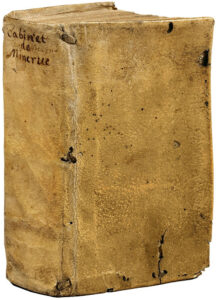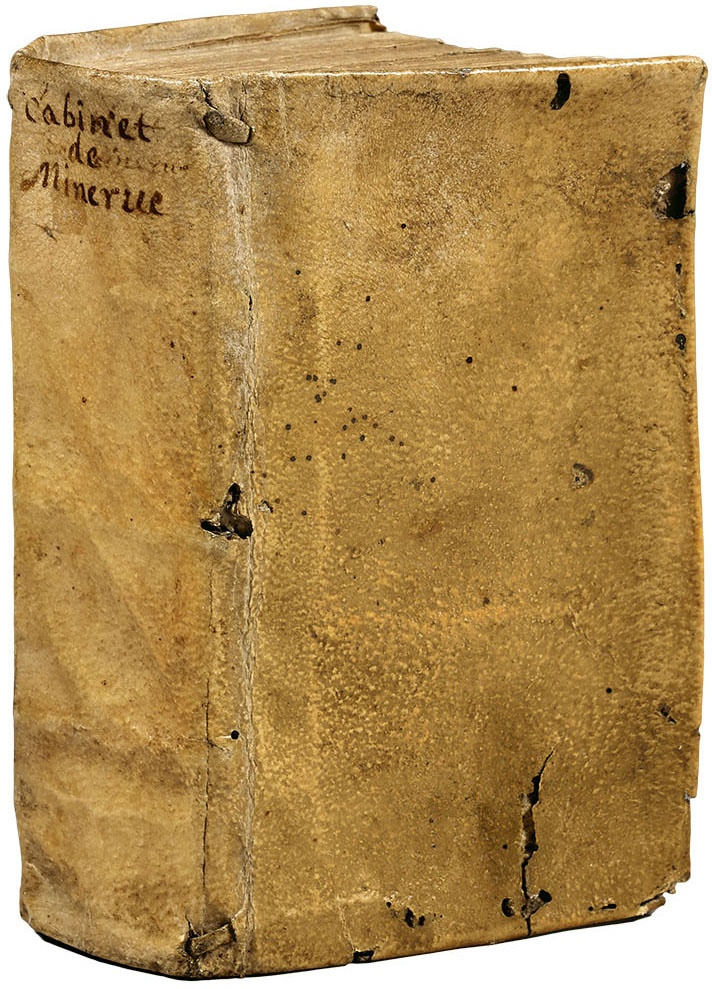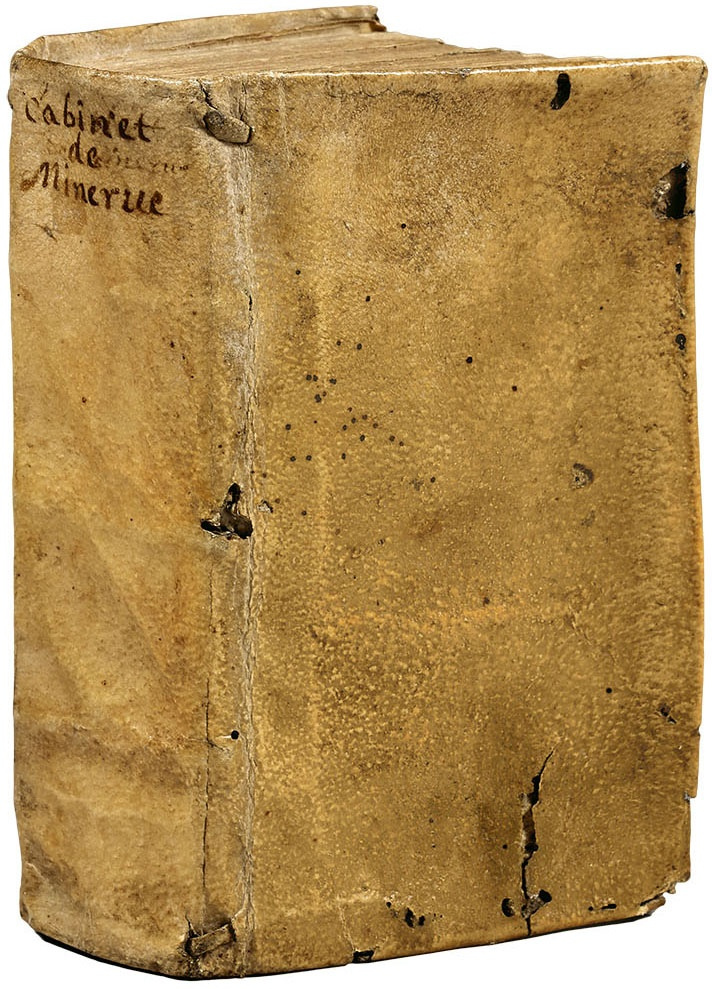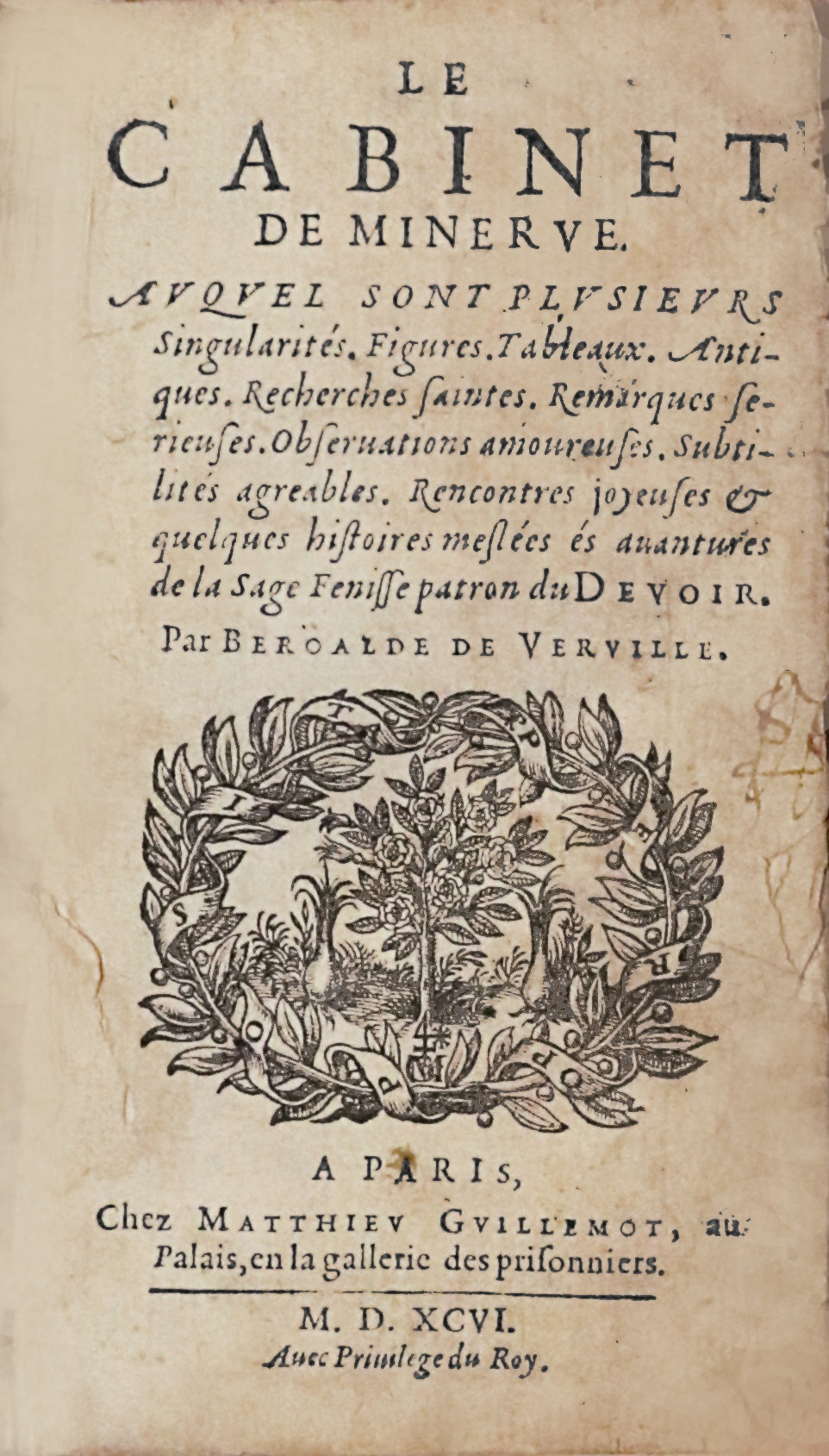Paris, Matthieu Guillemot, au Palais en la gallerie des prisonniers, 1596.
12mo [127 x 72 mm] of (12) ll. title included, 288 ll. Tear on the title-page without loss, small loss of paper in the upper corner of l. 95. Full ivory vellum, flat spine with handwritten title, sprinkled edges. Contemporary binding.
“First edition” (Catalogue Ambroise Firmin Didot, year 1883, n°423) of which no other copy has appeared on the public market since half-a-century.
Tchemerzine II, 187; Brunet, I, 805; Cioranescu, 3673; Gay, I, 440.
Extremely rare first edition of this best-selling novel from the end of the 16th century praised by modern criticism. Tchemerzine describes only two copies, none of which in a contemporary binding.
This novel, fifth and last part of the Aventures de Floride is complete in itself, is offered for sale alone and bears a different and individualized title (see Tchemerzine I- 664-665).
« Dans le ‘Cabinet de Minerve’ le récit romanesque s’unit à la réflexion « scientifique », aux descriptions d’œuvres d’art ». (Daniela Mauri).
The author has gathered here (in the fictitious form of visitors introduced in the Cabinet of Minerva for two days and one night, where nymphs explain to them the objects that are laying in front of them) many philosophical, literary, historical, religious and even scientific reflections, recipes and various observations.
The friends of Béroalde (1556-1626) are Pierre de L’Estoile, former pupil of his father, and Nicolas Le Digne; his two patrons are Pierre Brochard, Sir of Marigny, king’s advisor, to whom he dedicates several books, and René Crespin. Diverging both from the leaguers who rein in Paris, and from the partisans of the King of Navarre, he serves Henry III in the royal army (from 1586 to 1588). This is the time where we must place his abjuration of Calvinism and the beginning of the most intense period of his literary activity. In 1589, he settles in Tours, where the court and the Parliament have taken refuge (1589-1594), frequents a series of poets and “curious” minds, among which the poet Guy de Tours and the translator and writer Roland Brisset.
A very fertile writer, he left us an abundant and varied work. Forgotten for more than two centuries, from the first half of the 19th century, we rediscover this talented author.
“But it’s only since the “pioneering” study of V.L. Saulnier (1944) that criticism has luckily began to discover again this author with multiple facets. An “inquisitive” spirit, interested in several fields of knowledge (mathematics, optics, catoptrics, medicine, painting, sculpture, alchemy, to name only the main ones), he is indeed a very effective embodiment of the “scientist” typical of an era of transition between the Renaissance and the Baroque. His literary work can even be regarded as the ideal example of the deep changes that took place in the conceptions of knowledge at the turn between the 16th and 17th centuries, transition from an encyclopedic knowledge to a fragmented and unsystematic knowledge. Author of works in verse and prose belonging to different genres, he is at much ease in lyric, amorous, satirical poetry as in moral, political, “scientific”, philosophical texts (in the tradition of Scève and Du Bartas).
But Béroalde was also and above all an author of novels. He reveals from the beginning of his career as a novelist, a tendency to make the fundamental structures of the genre more or less chaotic, shimmering and “kaleidoscopic”: numerous characters who take turns acting as narrator, multiple stories that intertwine, labyrinthine narrative, which often causes the reader a sense of change of scenery, almost dizziness. Béroalde also likes to mix together the most disparate “materials” and one must recognize him the ability to always surprise, to constantly awaken our curiosity and to transmit us, like through a real contagion, a passion for the search for knowledge in all its forms. It is fundamental to note that Béroalde systematically adopts, especially at the beginning of his novels, but also during the narrative, a very effective narrative spring, perhaps borrowed to Rabelais, who, in the prologue of Gargantua, invited us to find the “substantificque mouelle” inside the “external appearance”. In the same way, Béroalde constantly urges us to look below what he calls in turn the “escorce”, the “feint” or the “artifice” of a seemingly light or even futile narrative, something deeper and more precious, identifying in his mind with the desire for knowledge and the quest for an artistic perfection that escapes from him unceasingly, as sometimes proves, by the way, the conscious and desired incompleteness of some of his novels” (Daniela Mauri).
Thus, in the Cabinet de Minerve, the novelistic narrative combines with scientific reflection and descriptions of works of art.
One of the rarest first editions of a French novel from the 16th century of which no copy has appeared on the public market since half-a-century.
It is preserved in its original binding in contemporary vellum, eminently enviable condition, the only two copies listed by Tchemerzine being in later binding.
OCLC lists only 3 copies among the public Institutions worldwide: B.n.F., University of Alberta and Princeton University.




